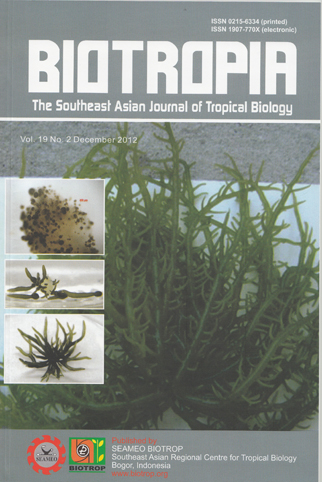
Tags
POSTHARVEST QUALITY IMPROVEMENT OF SORGHUM (Sorghum bicolor (L.) Moench) GRAINS
Content Language : English

The objectives of this study were (a) to investigate the effect of postharvest handling (threshing and storage) methods on the quality of sorghum (Sorghum bicolor (L) Moench) grains variety Numbu, in terms of the percentages of damaged grains and seed germination, population growth of S. zeamais, F. proliferatum and F. verticillioides; fumonisin B1 and carbohydrate contents, and the percentage of weight loss during storage. The change of moisture contents of sorghum grains was also recorded. Threshing was conducted using a stick of wood and a paddy thresher. Sorghum grains were packed in hermetic plastic bags. The conditions inside of the bags were airtight and normal conditions. Each bag with different conditions inside of the bag was introduced with 10 pairs of Sitophilus zeamais (1-14 days old). Sorghum was stored for one, two and three months of storage under warehouse conditions. The results showed, that during storage the moisture contents of sorghum were lower than that its standard safe moisture content (<14%). At the beginning of storage, the percentage of damaged grains caused by threshing using a stick of wood was higher than that of using a paddy thresher. During storage the increase of percentage of damaged grains was caused among others by the increase of S. zeamais population and the grains stored under normal conditions, consequently the percentage of weight loss was also increased. The percentage of seed germination of sorghum threshed using a stick of wood was lower than that of threshed using a paddy thresher. During storage the percentage of seed germination decreased with the increase of storage duration. Population of F. proliferatum and F. verticillioides decreased with the increase of storage duration. Fumonisin B1 content of sorghum threshed using a stick of wood was higher than that of threshed using a paddy thresher during one, two and three months of storage. Fumonisin B1 contents were considered low. In general carbohydrate content on sorghum threshed either using a stick of wood or a paddy thresher from at the beginning of storage up to three months of storage were not significantly different. Threshing using a paddy thresher was better compared to threshing using a stick of wood.

This work is licensed under a Creative Commons Attribution-NonCommercial-NoDerivatives 4.0 International License.
